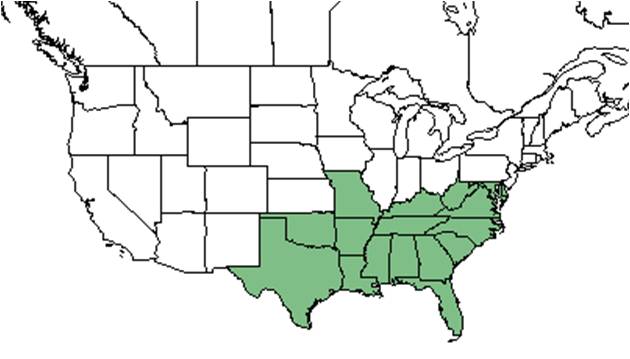Difference between revisions of "Vitis rotundifolia"
(→Description) |
|||
| Line 20: | Line 20: | ||
Common name: Muscadine | Common name: Muscadine | ||
==Taxonomic notes== | ==Taxonomic notes== | ||
| + | Synonym: ''Muscadinia rotundifolia'' (Michaux) Small var. ''rotundifolia''; ''Vitis rotundifolia'' Michaux var. ''rotundifolia''; ''Muscadinia rotundifolia'' (Michaux) Small | ||
==Description== | ==Description== | ||
<!-- Basic life history facts such as annual/perrenial, monoecious/dioecious, root morphology, seed type, etc. --> | <!-- Basic life history facts such as annual/perrenial, monoecious/dioecious, root morphology, seed type, etc. --> | ||
| Line 28: | Line 29: | ||
==Distribution== | ==Distribution== | ||
==Ecology== | ==Ecology== | ||
| − | ===Habitat=== <!--Natural communities, human disturbed habitats, topography, hydrology, soils, light, fire regime requirements for removal of competition, etc.--> | + | <!--===Habitat=== <!--Natural communities, human disturbed habitats, topography, hydrology, soils, light, fire regime requirements for removal of competition, etc.--> |
| − | ===Phenology=== <!--Timing off flowering, fruiting, seed dispersal, and environmental triggers. Cite PanFlora website if appropriate: http://www.gilnelson.com/PanFlora/ --> | + | <!--===Phenology=== <!--Timing off flowering, fruiting, seed dispersal, and environmental triggers. Cite PanFlora website if appropriate: http://www.gilnelson.com/PanFlora/ --> |
===Seed dispersal=== | ===Seed dispersal=== | ||
According to Kay Kirkman, a plant ecologist, this species disperses by being consumed by vertebrates (being assumed). <ref name="KK"> Kay Kirkman, unpublished data, 2015. </ref> | According to Kay Kirkman, a plant ecologist, this species disperses by being consumed by vertebrates (being assumed). <ref name="KK"> Kay Kirkman, unpublished data, 2015. </ref> | ||
| − | ===Seed bank and germination=== | + | <!--===Seed bank and germination===--> |
| − | ===Fire ecology=== <!--Fire tolerance, fire dependence, adaptive fire responses--> | + | <!--===Fire ecology===--> <!--Fire tolerance, fire dependence, adaptive fire responses--> |
===Pollination=== | ===Pollination=== | ||
The following Hymenoptera families and species were observed visiting flowers of ''Vitis rotundifolia'' at Archbold Biological Station (Deyrup 2015): | The following Hymenoptera families and species were observed visiting flowers of ''Vitis rotundifolia'' at Archbold Biological Station (Deyrup 2015): | ||
| Line 43: | Line 44: | ||
Megachilidae: ''Megachile brevis pseudobrevis, M. mendica, M. petulans'' | Megachilidae: ''Megachile brevis pseudobrevis, M. mendica, M. petulans'' | ||
| − | + | <!--===Use by animals===--> <!--Herbivory, granivory, insect hosting, etc.--> | |
| − | ===Use by animals=== <!--Herbivory, granivory, insect hosting, etc.--> | + | <!--===Diseases and parasites===--> |
| − | ===Diseases and parasites=== | ||
==Conservation and Management== | ==Conservation and Management== | ||
==Cultivation and restoration== | ==Cultivation and restoration== | ||
Revision as of 15:14, 7 June 2016
| Vitis rotundifolia | |
|---|---|

| |
| Photo by Kevin Robertson | |
| Scientific classification | |
| Kingdom: | Plantae |
| Division: | Magnoliophyta - Flowering plants |
| Class: | Magnoliopsida – Dicotyledons |
| Order: | Rhamnales |
| Family: | Vitaceae |
| Genus: | Vitis |
| Species: | V. rotundifolia |
| Binomial name | |
| Vitis rotundifolia Michx. | |

| |
| Natural range of Vitis rotundifolia from USDA NRCS Plants Database. | |
Common name: Muscadine
Contents
Taxonomic notes
Synonym: Muscadinia rotundifolia (Michaux) Small var. rotundifolia; Vitis rotundifolia Michaux var. rotundifolia; Muscadinia rotundifolia (Michaux) Small
Description
"High-climbing or trailing vines; pith brown, continuous or discontinuous through the nodes. Leaves simple, acute or acuminate, serrate, base cordate, petiolate. Inflorescences paniculate. Calyx flat, round, usually without lobes; petals 5, 0.5-2.5 mm long, cohering at the summit, separating at the base, falling at anthesis; disk of 5 connate or separate glands, 0.2-0.4 mm long; stigmas small, style conical, 0.2-0.5 mm long. Berry dark purple, globose; seeds 1-4 usually red or brown, pyriform, 4-7 mm long." [1]
"High-climbing vine with adhering bark, conspicuous tendrils, and pith continuous through node; young branches angled, puberulent. Leaves suborbicular or widely ovate, to 8 cm long or wide, glabrate or glabrous. Mature inflorescences to 5 cm long, few-fruited; berries 1-2 cm in diam.; seeds ca. 6 mm long." [1]
Distribution
Ecology
Seed dispersal
According to Kay Kirkman, a plant ecologist, this species disperses by being consumed by vertebrates (being assumed). [2]
Pollination
The following Hymenoptera families and species were observed visiting flowers of Vitis rotundifolia at Archbold Biological Station (Deyrup 2015):
Apidae: Apis mellifera, Bombus impatiens
Halictidae: Agapostemon splendens, Augochloropsis anonyma, A. sumptuosa, Lasioglossum placidensis
Megachilidae: Megachile brevis pseudobrevis, M. mendica, M. petulans
Conservation and Management
Cultivation and restoration
Photo Gallery
References and notes
Deyrup, M.A. and N.D. 2015. Database of observations of Hymenoptera visitations to flowers of plants on Archbold Biological Station, Florida, USA.